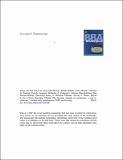Por favor, use este identificador para citar o enlazar a este item:
http://hdl.handle.net/10261/99026COMPARTIR / EXPORTAR:
 SHARE SHARE
 CORE
BASE CORE
BASE
|
|
| Visualizar otros formatos: MARC | Dublin Core | RDF | ORE | MODS | METS | DIDL | DATACITE | |

| Título: | The dynamic complex of cytochrome c6 and cytochrome f studied with paramagnetic NMR spectroscopy |
Autor: | Díaz-Moreno, Irene CSIC ORCID; Hulsker, R.; Skubak, O.; Foerster, J.M.; Cavazzini, D.; Finiguerra, M.G.; Díaz-Quintana, Antonio; Moreno-Beltrán, Blas CSIC ORCID; Rossi, G.-L. Ullmann, G.M.; Pannu, N.S.; Rosa, Miguel A. de la CSIC ORCID; Ubbink, Marcellus | Palabras clave: | Monte-Carlo modeling Paramagnetic relaxation enhancement Protein interaction Crystallography Electron transfer Photosynthesis |
Fecha de publicación: | 2014 | Citación: | Biochimica et Biophysica Acta - Bioenergetics 1837: 1305- 1315 (2014) | Resumen: | The rapid transfer of electrons in the photosynthetic redox chain is achieved by the formation of short-lived complexes of cytochrome b6f with the electron transfer proteins plastocyanin and cytochrome c6. A balance must exist between fast intermolecular electron transfer and rapid dissociation, which requires the formation of a complex that has limited specificity. The interaction of the soluble fragment of cytochrome f and cytochrome c6 from the cyanobacterium Nostoc sp. PCC 7119 was studied using NMR spectroscopy and X-ray diffraction. The crystal structures of wild type, M58H and M58C cytochrome c6 were determined. The M58C variant is an excellent low potential mimic of the wild type protein and was used in chemical shift perturbation and paramagnetic relaxation NMR experiments to characterize the complex with cytochrome f. The interaction is highly dynamic and can be described as a pure encounter complex, with no dominant stereospecific complex. Ensemble docking calculations and Monte-Carlo simulations suggest a model in which charge-charge interactions pre-orient cytochrome c6 with its haem edge toward cytochrome f to form an ensemble of orientations with extensive contacts between the hydrophobic patches on both cytochromes, bringing the two haem groups sufficiently close to allow for rapid electron transfer. This model of complex formation allows for a gradual increase and decrease of the hydrophobic interactions during association and dissociation, thus avoiding a high transition state barrier that would slow down the dissociation process. © 2014 Elsevier B.V. | URI: | http://hdl.handle.net/10261/99026 | DOI: | 10.1016/j.bbabio.2014.03.009 | Identificadores: | doi: 10.1016/j.bbabio.2014.03.009 issn: 1879-2650 |
| Aparece en las colecciones: | (IBVF) Artículos |
Ficheros en este ítem:
| Fichero | Descripción | Tamaño | Formato | |
|---|---|---|---|---|
| DiazMorenoetal_BBABio_2014.pdf | 799,42 kB | Adobe PDF |  Visualizar/Abrir |
CORE Recommender
SCOPUSTM
Citations
22
checked on 18-abr-2024
WEB OF SCIENCETM
Citations
22
checked on 28-feb-2024
Page view(s)
313
checked on 24-abr-2024
Download(s)
552
checked on 24-abr-2024
Google ScholarTM
Check
Altmetric
Altmetric
NOTA: Los ítems de Digital.CSIC están protegidos por copyright, con todos los derechos reservados, a menos que se indique lo contrario.
